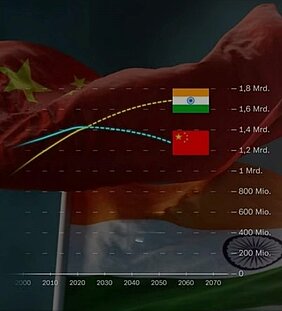For a long time, India was China's runner-up in terms of population. However, this is now over. India has overtaken China. But how did this come about?
China was the most populous country in the world. Between 1949 and 1979, China's population nearly doubled from 540 million to 969 million. However, such immense growth in China at that time was also accompanied by a negative consequence. We are talking about the greatest demographic catastrophe in Chinese history, the Great Chinese Famine, which occurred from 1958 to 1961. It is estimated that 15 to 40 million people died because of the scarcity of resources. In the years that followed, numerous attempts were made to contain the population. Probably the best-known measure is the controversial one-child policy, which has its origins in the early 1960s. In the 1980s, China broke the record of one billion inhabitants and today has a population of about 1.4 billion.
Since the 1950s, India has also seen a sharp increase in population growth. This is due in part to improvements in medicine as well as agriculture. India broke the one billion mark before the turn of the millennium and today has over 1.4 billion inhabitants. However, there is still no sign of population decline in India. One of the reasons why India is still growing compared to China is due to the age structure prevailing there. More than 40% of the Indian population is under 25 years of age, and in contrast, only just under 7.1% are over 65. Because of the age structure, India's potential demographic dividend is also very promising. The demographic dividend is the potential economic benefit that can be achieved by changing the age structure of a country as a result of development. India in particular is one of the most interesting countries in the world in this respect. The potential of such a large population is well exploited in India. According to a study by Statista, in which 12,000 people between the ages of 18 and 64 were surveyed per country, around 80% of those surveyed in India have a university degree. By way of comparison, the figure for Germany is around 24%. India's IT sector also has enormous potential. India is constantly expanding this potential through infrastructure investments. The Indian state invests around 100 billion euros per year in infrastructure. The Bangalore location is particularly important. Both the infrastructure investments and the geopolitical situation are currently playing into India's hands. Europe and the USA need new partners and want independence from China.
If we now look at India and China in the light of the above points, it is quite evident that India is currently making good use of its potential and will continue to do so in the future, whereas China is showing a downward trend. In terms of economic activity, demographic development plays a decisive role. India is also better positioned for the future than China due to its large number of young people. China, on the other hand, is now home to the largest number of older people in the world, which could lead to a further divergence in the economic dynamics of the two countries.
"India's population keeps growing. According to forecasts, by the year 2100 the country will even have twice as many inhabitants as China." (ZDF)
Do you want to learn more about the potential that India has to offer? We are at your disposal as a competent partner with many years of experience in topics related to outsourcing to India. Contact MeJuvante and get a comprehensive overview of our services.
